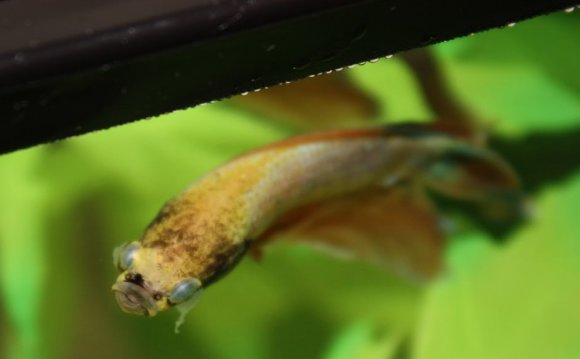
- An improved diet can often help the fish recover.
- Use chemical medications.
- Give preferred environment.
Stunted
Symptoms And Problems
The common symptoms of this ailment are that fish stop growing in size that is below the normal size and therefore, despite the overall size of the fish not getting bigger, the organs will actually still continue to grow and enlarge.
Treatment
- No exposure to stress.
- Appropriate feeding regime.
- Give proper nutrition.
- Limit overcrowding.
Blackspots
The common symptoms of this ailment are small dark spots on fins and body, small black speckles on body, flickering, small black smudges on fish, scratching against surfaces. Young fish have growth problems if heavily infected and thus they become very irritated.
- Commercially available treatments and preventatives.
- OTC medication for parasites.
Tubercles
The common symptoms of this ailment are raised white pimple-like growths on the head, pectoral fins and opercula, numerous nodules in the spleen, liver, kidney, heart, intestines, gills, muscles, sex glands, skin, eyes, and the skeleton. Fish become inert, hide in secluded places, move in violent rushes, stop feeding and swing on their side.
- Destroy affected fish.
- Add kanamycin or rifampicin in the food.
- Antibiotics should be added into the water.
- Medicines like rifampicin, kanamycin, chloramine, chlorine solution, doxycycline, monocycline, oxytetracycline, and tetracycline.
- Maintain a healthy environment.
- Provide with a nutritionally balanced diet
- Avoid overcrowding.
- Maintain high water quality.
Spine Curvature
The common symptoms of this ailment are curved or crooked spine skeletal deformity causing sluggish movement. Loss of appetite, discoloration and skin defects also observed.
- Remove infected fish.
- Add salt and raise the temperature.
- Treat with Penicillin ointment.
Bloating
The common symptoms of this ailment are female is unable or unwilling to expel the eggs because of Intestinal blockage and fish swims inverted.
- Epsom Salt treatment or Antibiotic Treatment.
- Change in diet is required including more variety and roughage.
- Feed a shelled pea.
- Feed a pea with a crystal of Epsom salts.
- Remove activated carbon.
- Increase aeration during treatment.
- Use of a quarantine tank is suggested.
Cysts
The common symptoms of this ailment varies greatly and they are pus-filled cysts under the skin which could be true tumors exuding pus and fluid having no effect on behavior at all but it hinders eating and may cause behavioral lethargy and malaise.
- Unknown, may be incurable if they turn out to be true tumors.
- Different treatment options that can be attempted.
Lumpy Body
The common symptoms of this ailment are that it manifest as growth occurring on the body surface where internal growths can also enlarge. Some skin growths are of same color as surrounding skin. Many abnormal skin and fin growths are harmless, but some are potentially life-threatening.
- Permanently isolate the affected fish.
- Assess overall aquarium/pond hygiene.
- There is no chemical cure.
- Fish’s immune system overpowers the virus, causing the lumps to disappear in time.
Restlessness
The common symptoms of this ailment are increased respiration, open gills, loss of color, gasping for air which causes fish to appear restless.
- Aeration of the water.
- Good balance of plants.
- All decaying plant matter, foods and algae should be removed from the aquarium.
- If the problem is serious, an immediate water change should be done. Adding fresh water will significantly increase oxygen levels.
Color Dullness
The common symptoms of this ailment are that some fish change colors temporarily and becomes very dull. Fish results in different color or color dullness and sometimes are less active due to indigestion.
Treatment
- Bright sunlight.
- Keep fish tank in an area that is well-lit.
- Keep tank clean.
- Maintain nitrate and ammonia levels.
- Regular treatment with a worming medication.
- Careful handling of fish between the store and home.
Note: If the fading is not due to a health concern, unnecessary treatment could be harmful, too.
Step by Step Fish Killing/Culling
Symptoms And Problems
The common symptoms of this ailment are that fish generally lie at the bottom of the tank, doesn’t eat, and lose weight with folded or torn fins, gasping for air resulting in rapid breathing.
- Separate sick fish.
- Maintain water quality.
- Clean the tank and change the water.
- Remove the filter and treat the water.
- Treat the water with a heat and salt method.
- Feed your fish veggies and low protein foods.
Male Crowntail
The common symptoms of this ailment are unique tail fin characteristics, flashy fin extensions.
Some fish are shy and stressed while other are more outgoing. Male crowntails are very aggressive to other members. They have unique tail fin design and spikes looks prominent and give the tail fin a crown-like appearance.









